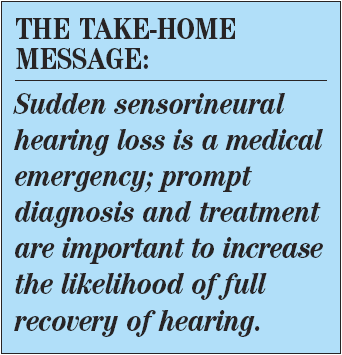Sudden Hearing Loss in a 52-Year-Old Man
A 52-year-old man presents with sudden unilateral hearing loss. While watching television the day before, he noted an abrupt decrease in hearing in his left ear. This was associated with a feeling of pressure and fullness in the ear and an intermittent sensation of “buzzing or ringing.”
This article was originally presented as an independent educational activity under the direction of CME LLC. The ability to receive CME credits has expired. The article is now presented here for your reference. CME LLC is no longer responsible for the presentation of the article.
A 52-year-old man presents with sudden unilateral hearing loss. While watching television the day before, he noted an abrupt decrease in hearing in his left ear. This was associated with a feeling of pressure and fullness in the ear and an intermittent sensation of “buzzing or ringing.” The hearing deficit was confirmed when he tried to use the telephone: the sound he perceived through the affected ear was markedly diminished and distorted. He attempted to clean his ear canal, but this did not help-nor was there any improvement the next morning.
HISTORY
The patient is otherwise healthy. He uses NSAIDs occasionally for musculoskeletal pain. He takes no other medications. He reports that he has had several episodes of mild vertigo in the past 24 hours, roughly concurrent with his ear symptoms.
PHYSICAL EXAMINATION
Vital signs are normal. Examination of the ears reveals a patent left ear canal and a readily visible and normal-appearing tympanic membrane. Cranial nerves II through XII are normal except for significant loss of hearing in the left ear; bedside tests suggest that the hearing loss is sensorineural rather than conduction-related. Extraocular movements are intact, and there is no nystagmus. The remainder of the physical findings, including the results of a detailed neurological examination, are normal.
LABORATORY RESULTS
Results of initial laboratory studies, including a complete blood cell count, biochemistry profile, and measurement of blood glucose and cholesterol levels, are normal.
Which of the following is the most likely diagnosis?A. Vestibular neuritis.
B. Blockage of the middle ear.
C. Idiopathic sudden sensorineural hearing loss.
D. Multiple sclerosis.
E. Perilymphatic fistula.
CORRECT ANSWER: C
Idiopathic sudden sensorineural hearing loss is defined as unexplained unilateral sensorineural hearing loss with onset over a period of less than 72 hours. This patient’s history and clinical symptoms fit all criteria for the condition.
Sensorineural versus conductive hearing loss. It is critical that sensorineural hearing loss be distinguished from a conductive loss because a sensorineural loss is an emergency that threatens long-term deafness and requires immediate evaluation and therapy. Bedside physical examination techniques can confirm that the loss is sensorineural in origin. These techniques include inspection of the ear canal and tympanic membrane, and a “hum test.”
To perform the hum test, have the patient hum softly and then tell you whether the sound of the humming is louder in the ear with the deficit (which would suggest a conductive loss) or in the normal ear (which would suggest a sensorineural loss). This patient reported that his humming sounded louder in the right ear.
If a 512-Hz tuning fork is available, the traditional Weber and Rinne tests can also be performed; results of these tests can provide further confirmation of a sensorineural origin. Weber and Rinne tests performed at this patient’s bedside indicated non-conductive–type hearing loss with lateralization to the normal ear, suggesting a contralateral sensorineural hearing loss.
Workup of sudden sensorineural hearing loss. Subsequent evaluation includes a complete audiogram to confirm and quantitate the severity of the loss and a gadolinium-enhanced MRI of the brain and temporal bone to exclude “retrocochlear” causes, which together account for roughly 15% of cases.1 Specific causes in this category include vestibular schwannoma; demyelinating diseases and stroke (approximately 1% of cases); and miscellaneous conditions, such as Mnire disease, trauma, Lyme disease, and fistulae, which account for the remainder of the cases of retrocochlear origin. Once these conditions are excluded, idiopathic sensorineural hearing loss (choice C) can be diagnosed.
Epidemiology. Idiopathic sensorineural hearing loss occurs in at least 5 to 20 of every 100,000 persons each year. The condition most often affects persons between the ages of 40 and 55 years; it affects men and women equally.2 A significant proportion of patients have additional vestibular symptoms or tinnitus, as this man did.2
Prognosis. Idiopathic sensorineural hearing loss can result in long-term deafness. When diagnosis and therapy are delayed, recovery of hearing is less likely. In addition, experts agree that prognosis is related to the severity of the hearing loss: patients with mild losses usually achieve full recovery; those with moderate losses have variable, incomplete recovery; and patients with severe losses experience little-if any-recovery.
Treatment. The data on optimal therapy for idiopathic sensorineural hearing loss are inadequate. Nonetheless, there is a consensus, based on weak and underpowered literature, that the standard of care consists of a “burst and taper” course of oral corticosteroids (eg, a 2-week course of oral prednisone, 60 mg/d, followed by a taper).2
Other therapies include intratympanic corticosteroid injections2,3 and antiviral agents, such as valacyclovir (in dosages similar to the anti-herpes regimens used in patients with Bell palsy).4 Intratympanic corticosteroid injections seem to be as effective as oral corticosteroids; antiviral regimens have failed to demonstrate added benefit compared with corticosteroid therapy alone.
Other causes of sudden hearing loss and vertigo. Blockage of the ear canal (choice B) can cause hearing loss. However, blockage was easily excluded in this patient: the ear canal was patent with good visualization of the tympanic membrane. Moreover, bedside Weber and Rinne tests indicated non-conductive–type hearing loss with lateralization to the normal ear, suggesting a contralateral sensorineural hearing loss.

Multiple sclerosis (choice D) is one of the nonneoplastic retrocochlear disorders that account for about 1% of the cases of sudden sensorineural hearing loss. These entities can be diagnosed and excluded by imaging techniques such as gadolinium-enhanced MRI of the brain and temporal bone. Such studies are indicated here; however, the absence of any neurological findings other than those associated with cranial nerve VIII, as well as the low incidence of sensorineural hearing loss associated with multiple sclerosis, makes this diagnosis unlikely.
Vestibular neuritis (choice A) is a common cause of acute spontaneous vertigo. However, affected patients usually have vertigo that is far more severe than the mild episodes reported by this man. Also, associated hearing loss is not seen with vestibular neuritis; results of hearing tests performed at the bedside and of formal audiometry are normal.5
Perilymphatic fistula (choice E) is also in the differential of acute vertigo, and perilymphatic fistula can be accompanied by hearing loss. However, vertigo was only a minor part of this patient’s syndrome. Moreover, the absence of associated head trauma, barotrauma, or other inciting causes essentially excludes this diagnosis.
Outcome of this case. An MRI examination of the patient’s brain revealed no neoplasm or demyelination. Audiometry confirmed a significant reduction in hearing acuity of neural origin on the left.
The patient was treated empirically with a course of corticosteroids. His hearing gradually improved over the next several weeks (either as a result of this therapy or incidentally), and by 3 months, he had recovered roughly 75% of his hearing. He was cautioned to avoid high-risk situations, such as loud-noise environments and scuba diving.
References:
REFERENCES:
1.
Shaia FT, Sheehy JL. Sudden sensori-neural hearing impairment: a report of 1,220 cases.
Laryngoscope.
1976;86:389-398.
2.
Rauch SD. Clinical practice. Idiopathic sudden sensorineural hearing loss.
N Engl J Med.
2008;359:833-840.
3.
Hughes GB, Freedman MA, Haberkamp TJ, Guay ME. Sudden sensorineural hearing loss.
Otolaryngol Clin North Am.
1996;29:393-405.
4.
Tucci DL, Farmer JC Jr, Kitch RD, Witsell DL. Treatment of sudden sensorineural hearing loss with systemic steroids and valacyclovir.
Otol Neurotol.
2002;23:301-308.
5
. Baloh RW. Clinical practice. Vestibular neuritis.
N Engl J Med.
2003;348:1027-1032.







